Most of the examinations of stock manipulation published here on deepcapture.com take place after the fact, the damage being done. However, we’ve become aware of instances of apparently illegal, manipulative trading in several companies’ stocks, happening right now, which we have the ability to monitor and report on in nearly real time.
I’ll start with Sears Holdings Corporation (NASDAQ:SHLD).
A few months ago, an unusual trading pattern in shares of Sears emerged, in which large blocks of shares change hands within minutes of deep in-the-money call options equivalent to precisely the same numbers of shares in these blocks. This behavior is consistent with the illegal “reset” transaction described in the enforcement case brought by the SEC against naked short seller Steven M. Hazan:
“…a market participant who has a “fail-to-deliver” position in a threshold security buys shares of that security while simultaneously selling short-term, deep in-the-money call options to – or buying short-term, deep in-the-money put options from – the counterparty to the share purchase. The purchase of shares creates the illusion that the market participant has satisfied the close out obligation of Reg SHO. However, the shares that are apparently purchased in the reset transactions are never actually delivered to the purchaser because on the day after executing the reset, the option is either exercised (if a call) or assigned (if a put), transferring the shares back to the party that apparently sold them the previous day. This paired transaction allows the market participant with the fail-to-deliver position to effectively borrow the stock for a day, in order to appear to have satisfied the close out requirement of Rule 203(b)(3).”
If you want to see each of these reset transactions in detail, you can do so here. But if you’re content with the bottom lines, take a look at the following table, keeping in mind each call option contract gives the buyer the right to purchase 100 shares of the underlying stock (meaning, these trades were undeniably “matched” to one another).
| Date | Call option contracts | Equities block size | Date | Call option contracts | Equities block size | |
| 12/3/09 | 6,166 | 616,600 | 1/4/10 | 10,374 | 1,037,400 | |
| 12/4/09 | 6,194 | 619,400 | 1/5/10 | 10,368 | 1,036,800 | |
| 12/7/09 | 6,369 | 636,900 | 1/6/10 | 10,610 | 1,061,000 | |
| 12/8/09 | 6,668 | 666,800 | 1/7/10 | 10,972 | 1,097,200 | |
| 12/9/09 | 7,287 | 728,700 | 1/8/10 | 16,032 | 1,603,200 | |
| 12/10/09 | 7,749 | 774,900 | 1/11/10 | 15,106 | 1,510,600 | |
| 12/11/09 | 7,958 | 795,800 | 1/12/10 | 15,050 | 1,505,000 | |
| 12/14/09 | 8,376 | 837,600 | 1/13/10 | 15,107 | 1,510,700 | |
| 12/15/09 | 8,387 | 838,700 | 1/14/10 | 15,054 | 1,505,400 | |
| 12/16/09 | 8,876 | 887,600 | 1/19/10 | 8,403 | 840,300 | |
| 12/17/09 | 8,654 | 865,400 | 1/20/10 | 8,483 | 848,300 | |
| 12/18/09 | 4,767 | 476,700 | 1/21/10 | 8,321 | 832,100 | |
| 12/21/09 | 6,598 | 659,800 | 1/22/10 | 8,352 | 835,200 | |
| 12/22/09 | 6,918 | 691,800 | 1/25/10 | 8,535 | 853,500 | |
| 12/23/09 | 7,433 | 743,300 | 1/26/10 | 8,561 | 856,100 | |
| 12/24/09 | 8,444 | 884,400 | 1/27/10 | 8,622 | 862,200 | |
| 12/28/09 | 8,773 | 877,300 | 1/28/10 | 8,490 | 849,000 | |
| 12/29/09 | 9,087 | 908,700 | 1/29/10 | 8,326 | 832,600 | |
| 12/30/09 | 9,459 | 945,900 | ||||
| 12/31/09 | 9,830 | 938,000 |
Take a look at how these blocks trades appear when charted.
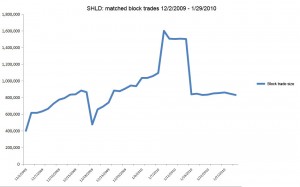
Looking at the relationship between these matched blocks and the delivery failure data currently available suggests the blocks are a pretty reliable predictor of delivery failures reported two days later.
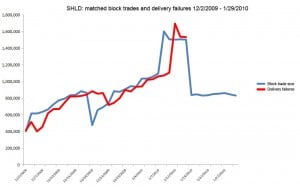
Moving fails back two trading days we see just how reliable a predictor these matched block trades really are.
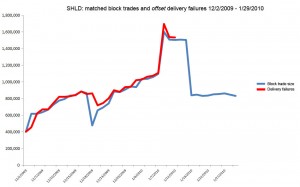
On average, SHLD fails are roughly 102% of these matched blocks. Given that relationship, I feel quite confident predicting how the as-yet-unreleased SHLD delivery failures will appear (note the dashed line).
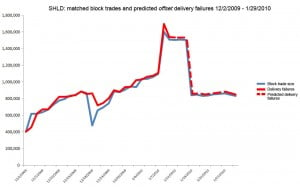
Now for the good and bad news inherent to this situation.
The good news is: this unusual market activity is fairly easy to spot.
The bad news is: despite being easy to spot, in recent months multiple companies have come under identical attack, suggesting whoever is responsible is not too concerned about the consequences of overtly violating the securities laws…a familiar situation for anybody who’s followed deepcapture.com for any length of time.
I’ll have more on this subject as soon as the SEC fails data are released, so stay tuned.



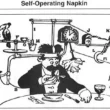



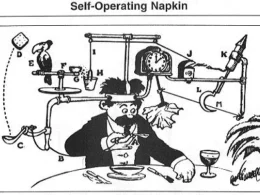
I’ve witnessed these interesting trades myself and wondered if the market maker(s) had a big hand in the trades. The recent big breakout in Dendreon was prefixed with a few massive options trades on each jump northward. I’ve got to wonder if we’ll see a spike in FTDs the following few days after each major options block trade.
Great work Judd!
Whoever controls the military controls Rome.. We need the Soldiers to protect the people vs Wall ST.
I’m sorry but I am not seeing any meaningful impact to the stock price of SHLD because of this naked short selling. Is it possible we are jumping the gun here?
Wow, 3.1mn FTDs for AMED on Feb 23rd.
I’ve been studying AMED trading records for two weeks, waiting for the latest batch of fails data to be released to publish what I’ve found. Of course the numbers came out this morning, and I’ve been scratching my head looking at them ever since, because they don’t add up.
If it’s any consolation, I suspect the numbers are incorrect, because the trading comes nowhere near supporting them. In fact, 3.1m is 4.4x the volume for 2/18, which is the day those shares must have entered the market.
In addition, the other indicators I’ve learned accurately predict fails in SHLD and AMED (and others) suggest the real number is about 300,000 fails. Of course that’s 300k too many, but a far cry from 3.1m.
Agreed. Something seems funky there.
Any possibility of a link to the block of put options on Dec 16?
December 16 does happen to be within a couple of days of the time the funny business got started, and those 1,000 contract put blocks might have something to do with it, but they don’t figure into any of the tell-tale transaction patterns I’ve identified so far. Much more significant (and I’ll have more for you on this very soon) are the 16 blocks of 10 contract puts and calls sold on the 17th with identical at-the-money strikes and expiration dates.
I am wondering if a naked short position purchased today shows up
as a real transaction with the number of shares being counted to
the day’s total. In a true short position, shares are supposed
to be borrowed first, creating a proper paper entry, correct?
QUestion 1. where did you get the information on all those trades?
Question 2. why has the volume dried up in SHLD in the last week?
1- Deep Capture purchases equities and option trading data for all issues. We’re able to examine every tick.
2- It’s not that the volume in SHLD has dried up — it’s that months of naked shorting the stock made it artificially high.
Thanks Judd,
That billion dollar short position looks top heavy with the lower volumes.
Why isn’t the government investigating SHC?
We’re a bunch of volunteers and opening a brand new scheme in our community. Your web site offered us with valuable information to work on. You’ve performed a formidable activity and our entire group shall be thankful to you.
Howdy very nice web site!! Guy .. Excellent .. Wonderful ..
I will bookmark your blog and take the feeds also?
I am happy to find a lot of helpful information right here within
the submit, we want work out more techniques on this regard, thank you for sharing.
. . . . .